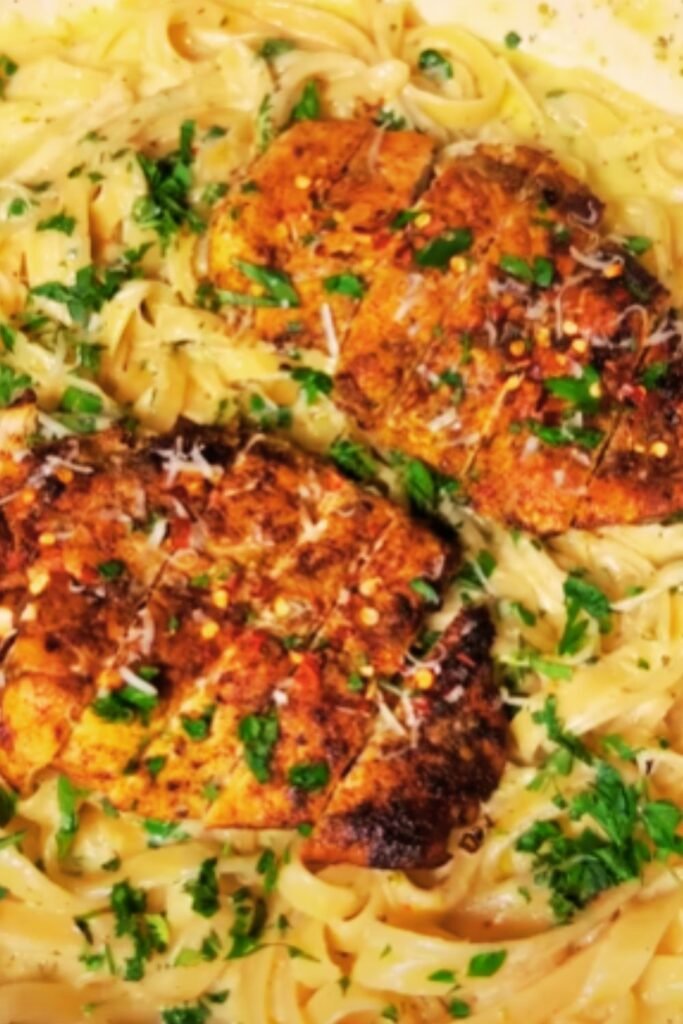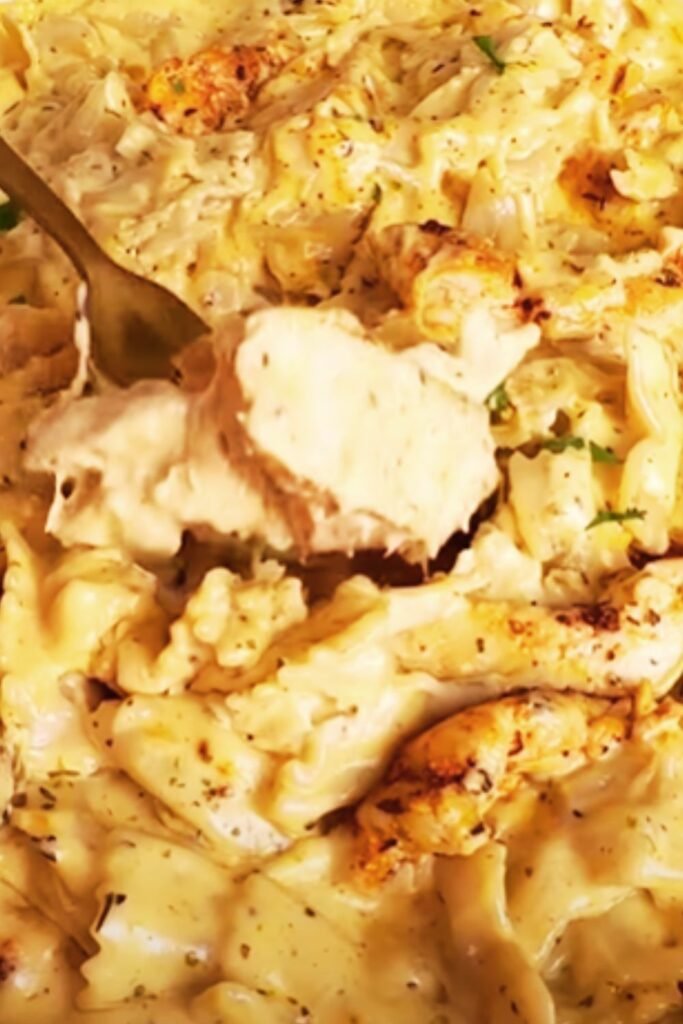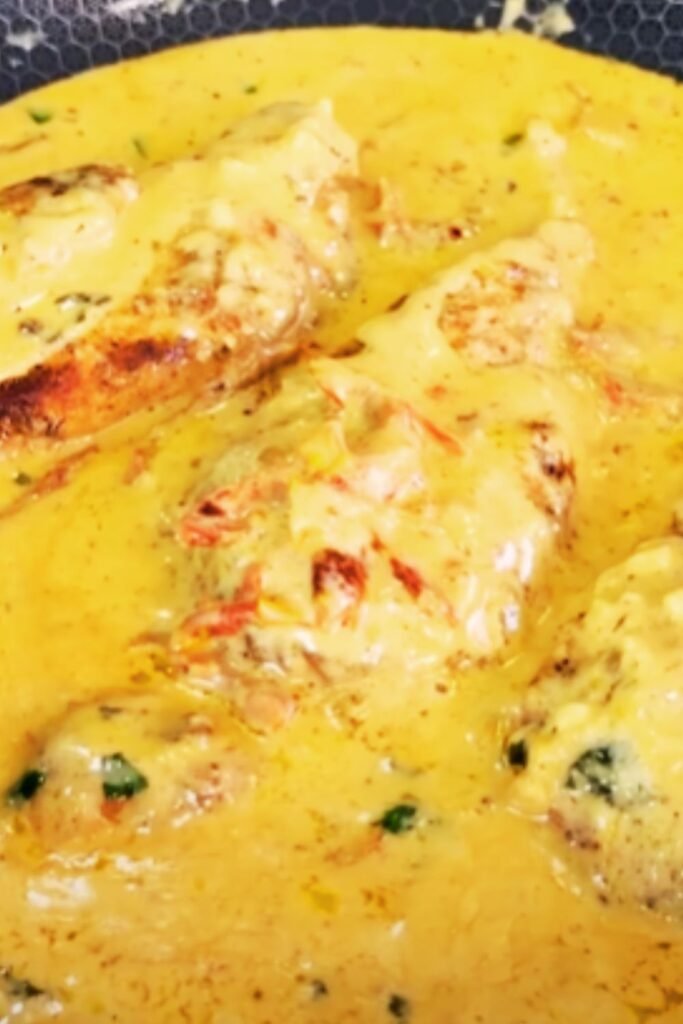There’s something absolutely magical about the combination of tender chicken, aromatic garlic, and rich Parmesan cheese swirling together in a creamy pasta sauce. I’ve been perfecting this Creamy Chicken Garlic Parmesan Pasta recipe for years, and I can confidently say it’s become my go-to dish when I want to create something that feels both sophisticated and comforting.
This recipe transforms simple ingredients into restaurant-quality pasta that’ll have your family asking for seconds (and thirds). The silky cream sauce clings perfectly to each strand of pasta, while chunks of seasoned chicken provide protein and substance. What I love most about this dish is how it manages to be both elegant enough for dinner parties and cozy enough for weeknight family meals.
Why This Recipe Works So Well
I’ve tried countless variations of creamy pasta dishes, but this particular combination hits all the right notes. The garlic provides aromatic depth without overwhelming the palate, while the Parmesan adds both richness and a subtle nutty flavor that complements the chicken beautifully. The cream sauce is neither too thick nor too thin – it’s just right for coating pasta without feeling heavy.
What sets my version apart is the technique I use for building layers of flavor. Instead of simply throwing everything together, I carefully develop each component to ensure maximum taste impact. The chicken gets properly seared for a golden crust, the garlic is sautéed until fragrant but not burnt, and the Parmesan is added gradually to prevent clumping.
Essential Ingredients Breakdown
Understanding your ingredients is crucial for achieving the best results. Let me walk you through each component and explain why it matters:
Chicken Selection
- Chicken breasts: Lean protein that cooks quickly and evenly
- Chicken thighs: Higher fat content provides more flavor and stays moist
- Preparation: Cut into uniform pieces for consistent cooking
Pasta Choices
- Fettuccine: Classic wide noodles perfect for cream sauces
- Penne: Tube shape holds sauce beautifully
- Linguine: Elegant long strands that twirl nicely
- Rigatoni: Ridged tubes capture every bit of sauce
Cream Components
- Heavy cream: 35% fat content for richness and stability
- Half-and-half: Lighter option that still provides creaminess
- Butter: Adds silkiness and helps emulsify the sauce
Cheese Considerations
- Freshly grated Parmesan: Superior melting and flavor
- Pre-grated alternatives: Convenient but less flavorful
- Pecorino Romano: Sharp alternative for more intense taste
Complete Ingredient List and Measurements
| Ingredient | Amount | Purpose | Substitution Options |
|---|---|---|---|
| Chicken breast or thighs | 1.5 lbs | Main protein | Turkey breast, shrimp |
| Pasta (fettuccine/penne) | 1 lb | Base carbohydrate | Any long or short pasta |
| Heavy cream | 1 cup | Sauce base | Half-and-half, milk + flour |
| Fresh Parmesan cheese | 1 cup grated | Flavor and richness | Pecorino Romano, Asiago |
| Garlic cloves | 6-8 large | Aromatic base | Garlic powder (1 tsp) |
| Butter | 4 tablespoons | Sauce foundation | Olive oil, margarine |
| Olive oil | 2 tablespoons | Cooking fat | Vegetable oil, butter |
| Chicken broth | 1/2 cup | Flavor depth | Vegetable broth, white wine |
| Italian seasoning | 2 teaspoons | Herb blend | Fresh herbs mix |
| Salt | To taste | Seasoning | Sea salt, kosher salt |
| Black pepper | 1/2 teaspoon | Spice | White pepper, red pepper |
| Fresh parsley | 1/4 cup chopped | Garnish and color | Basil, chives |

Step-by-Step Cooking Instructions
Preparation Phase (15 minutes)
I always start by getting everything ready before I begin cooking. This French technique called “mise en place” ensures smooth cooking without scrambling for ingredients mid-process.
Chicken Preparation:
- Remove chicken from refrigerator 20 minutes before cooking
- Pat completely dry with paper towels
- Cut into uniform 1-inch pieces for even cooking
- Season generously with salt, pepper, and half the Italian seasoning
Other Prep Work:
- Grate Parmesan cheese fresh for best results
- Mince garlic finely (I use a microplane grater)
- Chop parsley and set aside for garnish
- Fill large pot with salted water for pasta
Cooking the Chicken (8-10 minutes)
Heat Management: Start with medium-high heat in a large skillet or heavy-bottomed pan. I prefer using a 12-inch skillet for adequate space – overcrowding leads to steaming instead of searing.
Searing Process:
- Add olive oil to hot pan and swirl to coat
- Place chicken pieces in single layer, don’t move for 3-4 minutes
- Flip when golden brown crust forms
- Cook additional 3-4 minutes until internal temperature reaches 165°F
- Remove chicken to plate and cover with foil
Creating the Sauce Foundation (5-7 minutes)
Garlic Aromatics: In the same pan with chicken drippings:
- Reduce heat to medium-low
- Add butter and let melt completely
- Add minced garlic, stirring constantly for 60-90 seconds
- Watch carefully – burnt garlic turns bitter
Building Flavor Layers:
- Pour in chicken broth to deglaze pan
- Scrape up browned bits with wooden spoon
- Let broth reduce by half (about 2-3 minutes)
- These concentrated flavors become your sauce foundation
Pasta Cooking Timeline (8-12 minutes)
Timing Coordination: Start pasta water when you begin the sauce. This ensures everything finishes simultaneously.
Cooking Method:
- Bring salted water to rolling boil (1 tablespoon salt per quart)
- Add pasta and stir immediately to prevent sticking
- Cook 1-2 minutes less than package directions for al dente
- Reserve 1 cup pasta cooking water before draining
- The starchy pasta water helps bind the sauce
Sauce Assembly and Finishing (8-10 minutes)
Cream Integration: This is where technique really matters. Adding cream properly prevents curdling and ensures smoothness.
- Pour heavy cream into garlic butter mixture
- Whisk constantly while bringing to gentle simmer
- Never let it boil vigorously – this causes separation
- Simmer 3-4 minutes until slightly thickened
Cheese Incorporation:
- Remove pan from direct heat
- Add Parmesan in three additions, whisking after each
- If sauce seems thick, add pasta water gradually
- Return chicken to pan with any accumulated juices
Final Assembly:
- Add drained pasta to sauce pan
- Toss continuously for 2-3 minutes
- Pasta should be well-coated but not swimming in sauce
- Adjust seasoning with salt and pepper
- Add fresh parsley just before serving

Nutritional Information and Serving Details
| Nutritional Component | Per Serving (6 servings) | Daily Value % |
|---|---|---|
| Calories | 520-580 | 26-29% |
| Total Fat | 22-28g | 34-43% |
| Saturated Fat | 12-15g | 60-75% |
| Cholesterol | 95-110mg | 32-37% |
| Sodium | 680-750mg | 30-33% |
| Carbohydrates | 45-52g | 15-17% |
| Dietary Fiber | 2-3g | 8-12% |
| Protein | 35-42g | 70-84% |
| Calcium | 280-320mg | 28-32% |
| Iron | 2-3mg | 11-17% |
Serving Specifications:
- Portion size: 1.5-2 cups per serving
- Servings per recipe: 4-6 generous portions
- Preparation time: 25-30 minutes
- Active cooking time: 35-40 minutes
- Total time: 60-70 minutes
Variation Ideas and Customizations
Protein Variations
Seafood Options:
- Substitute shrimp for chicken (cook 2-3 minutes per side)
- Use scallops for elegant dinner party version
- Try salmon chunks for omega-3 boost
Alternative Proteins:
- Italian sausage adds spicy kick
- Turkey breast works identically to chicken
- For vegetarian version, use mushrooms or chickpeas
Vegetable Additions
I love adding vegetables for color, nutrition, and texture variety:
Quick-Cooking Vegetables:
- Baby spinach (wilts in final minute)
- Cherry tomatoes (add with chicken)
- Bell peppers (sauté with garlic)
- Asparagus tips (blanch separately)
Longer-Cooking Options:
- Broccoli florets (steam until tender-crisp)
- Zucchini ribbons (add in last 2 minutes)
- Mushrooms (sauté until golden)
- Sun-dried tomatoes (rehydrate first)
Flavor Profile Modifications
Italian-Inspired:
- Add dried basil and oregano
- Include roasted red peppers
- Finish with fresh basil leaves
- Use Pecorino Romano instead of Parmesan
Mediterranean Twist:
- Include kalamata olives
- Add artichoke hearts
- Use fresh herbs like oregano and thyme
- Finish with lemon zest

Troubleshooting Common Issues
Sauce Problems and Solutions
Lumpy or Separated Sauce:
- Cause: Temperature too high or cheese added too quickly
- Prevention: Keep heat at medium-low, add cheese gradually
- Fix: Remove from heat, whisk in tablespoon of cold cream
Sauce Too Thick:
- Cause: Over-reduction or too much cheese
- Prevention: Reserve pasta water for thinning
- Fix: Add warm pasta water or broth gradually while whisking
Sauce Too Thin:
- Cause: Not enough reduction time or cheese
- Prevention: Simmer longer, add more Parmesan
- Fix: Simmer uncovered 2-3 more minutes, add cheese
Bland Flavor:
- Cause: Under-seasoning or insufficient garlic
- Prevention: Taste and adjust throughout cooking
- Fix: Add salt, pepper, garlic powder, or fresh herbs
Chicken Issues
Dry Chicken:
- Cause: Overcooking or insufficient fat
- Prevention: Use meat thermometer, don’t overcook
- Fix: Next time, use thighs or add extra butter
Tough Chicken:
- Cause: High heat or old meat
- Prevention: Medium heat, fresh chicken, proper rest time
- Fix: Slice thinly against grain before serving
Storage and Reheating Guidelines
Proper Storage Methods
Refrigerator Storage:
- Cool completely before refrigerating
- Store in airtight containers up to 3-4 days
- Keep sauce and pasta together to prevent drying
- Label with date for food safety
Freezer Storage:
- Freezes adequately for up to 2 months
- Portion into family-sized containers
- Leave headspace for expansion
- Thaw overnight in refrigerator
Reheating Techniques
Stovetop Method (Recommended):
- Add 2-3 tablespoons milk or cream to cold pasta
- Heat in large skillet over medium-low heat
- Stir frequently to prevent sticking
- Add more liquid as needed for creaminess
- Heat until steaming throughout
Microwave Method:
- Use microwave-safe dish with cover
- Add splash of milk or cream
- Heat 30-second intervals, stirring between
- Continue until heated through
Oven Method:
- Preheat to 350°F
- Transfer to covered baking dish
- Add cream or broth to prevent drying
- Bake 20-25 minutes, stirring halfway
Serving Suggestions and Pairings
Side Dish Recommendations
Vegetable Sides: My favorite accompaniments enhance rather than compete with the rich pasta:
- Caesar salad: Crisp romaine cuts through richness
- Roasted asparagus: Simple preparation with olive oil and lemon
- Steamed broccoli: Light, healthy contrast
- Garlic bread: Classic pairing (though carb-heavy)
Lighter Options:
- Mixed green salad with balsamic vinaigrette
- Roasted Brussels sprouts with bacon
- Sautéed green beans with almonds
- Caprese salad with fresh mozzarella
Beverage Pairings
Non-Alcoholic Options:
- Sparkling water with lemon
- Iced tea (unsweetened)
- Italian sodas
- Fresh lemonade
- Sparkling apple cider
Hot Beverages:
- Italian roast coffee
- Herbal teas (chamomile or peppermint)
- Hot chocolate for kids
Make-Ahead and Meal Prep Strategies
Components You Can Prepare Ahead
Day Before:
- Cook and season chicken (refrigerate separately)
- Grate Parmesan cheese
- Prep vegetables (wash, chop, store properly)
- Make garlic butter mixture (refrigerate covered)
Morning Of:
- Assemble all ingredients
- Pre-measure seasonings
- Set up cooking station
- Bring ingredients to room temperature
Meal Prep Considerations
Batch Cooking:
- Double recipe for multiple meals
- Portion into individual containers
- Freeze half for future quick dinners
- Cook pasta slightly underdone for reheating
Assembly Line Method:
- Prep proteins for multiple recipes simultaneously
- Make large batch of garlic butter base
- Pre-portion vegetables for several meals
- Cook pasta in large batches weekly
Professional Tips for Perfect Results
Restaurant-Style Techniques
Temperature Control: I learned this from working in professional kitchens – consistent temperature is everything. Keep your heat steady and adjust gradually rather than making dramatic changes.
Timing Coordination: Professional cooks call this “plating up” – having everything ready simultaneously. Start your longest-cooking component first and work backwards.
Sauce Consistency: The sauce should coat a spoon but still flow freely. If you can draw a line through it with your finger that holds for 2-3 seconds, it’s perfect.
Seasoning Layers: Season at every step rather than just at the end. Salt the pasta water, season the chicken, taste the sauce multiple times during cooking.
Equipment Recommendations
Essential Tools:
- Heavy-bottomed 12-inch skillet or sauté pan
- Large pasta pot (6-8 quarts minimum)
- Fine-mesh strainer for pasta
- Microplane grater for cheese and garlic
- Wooden spoon for stirring
- Instant-read thermometer
Nice-to-Have Items:
- Pasta fork for tossing
- Large serving bowls (warm them first)
- Cheese grater with storage container
- Silicone spatula set
- Kitchen scale for precise measurements
Frequently Asked Questions
Q: Can I use pre-cooked rotisserie chicken? Absolutely! This is actually one of my favorite shortcuts for busy weeknights. Remove the skin and bones, then shred or chop the meat into bite-sized pieces. Add it to the sauce during the last 2-3 minutes of cooking just to warm through. Since it’s already cooked, you don’t want to overdo it or it’ll become dry and tough.
Q: What’s the best pasta shape for this recipe? While I prefer fettuccine for its classic appeal, the truth is that any pasta shape works well. Long pastas like linguine or angel hair are elegant, while short shapes like penne or rigatoni are practical for families with kids. The key is matching the pasta size to your sauce consistency – thicker sauces work better with heartier pasta shapes.
Q: Can I make this recipe dairy-free? Yes, with some modifications! Replace the heavy cream with full-fat coconut milk or cashew cream. Use nutritional yeast instead of Parmesan cheese, and substitute the butter with olive oil or vegan butter. The flavor profile changes, but it’s still delicious. I’d add extra herbs and garlic to compensate for the lost richness from the dairy.
Q: How do I prevent the sauce from breaking or curdling? Temperature control is crucial. Never let the cream boil vigorously – keep it at a gentle simmer. When adding cheese, remove the pan from direct heat and add it gradually while whisking constantly. If your sauce does break, try whisking in a tablespoon of cold cream or a splash of pasta water off the heat.
Q: Can I freeze this pasta dish? While it’s possible to freeze, cream-based pasta dishes don’t always reheat perfectly. The texture can become slightly grainy. If you do freeze it, portion it into serving sizes and add a splash of fresh cream when reheating. For best results, I recommend making fresh or storing in the refrigerator for up to 4 days.
Q: What if I don’t have heavy cream? You have several options! Half-and-half works but won’t be as rich. You can also make a substitute by mixing 3/4 cup milk with 1/4 cup melted butter. For an even lighter version, use milk thickened with a tablespoon of flour whisked in slowly. Greek yogurt mixed with a little milk also works, though add it off the heat to prevent curdling.
Q: How can I add more vegetables to this recipe? I love making this dish more nutritious with vegetables! Quick-cooking options like spinach, cherry tomatoes, or bell peppers can be added directly to the pan. For heartier vegetables like broccoli or asparagus, I blanch them separately first, then fold them in at the end. Roasted vegetables like zucchini or mushrooms add wonderful depth when stirred in just before serving.
Q: Is there a way to reduce the calories in this recipe? Several modifications can lighten this dish. Use chicken breast instead of thighs, replace half the cream with low-sodium chicken broth, reduce the cheese slightly, and bulk up with extra vegetables. You can also serve smaller portions over a bed of zucchini noodles or use whole wheat pasta for more fiber.
Q: What’s the best way to reheat leftovers? The stovetop method gives the best results. Add a splash of cream or milk to the cold pasta, then heat it slowly in a skillet over medium-low heat, stirring frequently. This prevents the pasta from drying out and helps restore the sauce’s creamy texture. Avoid high heat, which can make the sauce grainy.
Q: Can I use garlic powder instead of fresh garlic? While fresh garlic provides the best flavor, garlic powder works in a pinch. Use about 1 teaspoon of garlic powder in place of the fresh cloves. Add it with the other dried seasonings rather than sautéing it like fresh garlic. The flavor won’t be quite as complex, but it’s still delicious.
This Creamy Chicken Garlic Parmesan Pasta has become my signature dish for good reason. It’s reliable, impressive, and endlessly adaptable to your family’s preferences. The combination of techniques I’ve shared here will help you create restaurant-quality results in your own kitchen. Whether you’re cooking for a special occasion or just want to elevate a weeknight dinner, this recipe delivers every single time.
Remember, cooking is about more than just following instructions – it’s about understanding how flavors work together and adjusting to your taste. Don’t be afraid to make this recipe your own by adding your favorite vegetables, adjusting the seasoning, or trying different pasta shapes. The foundation I’ve provided here is solid, but your personal touches will make it truly special.
Take your time, taste as you go, and most importantly, enjoy the process. There’s something deeply satisfying about creating a dish that brings people together around the table, and this creamy, comforting pasta does exactly that. Happy cooking!